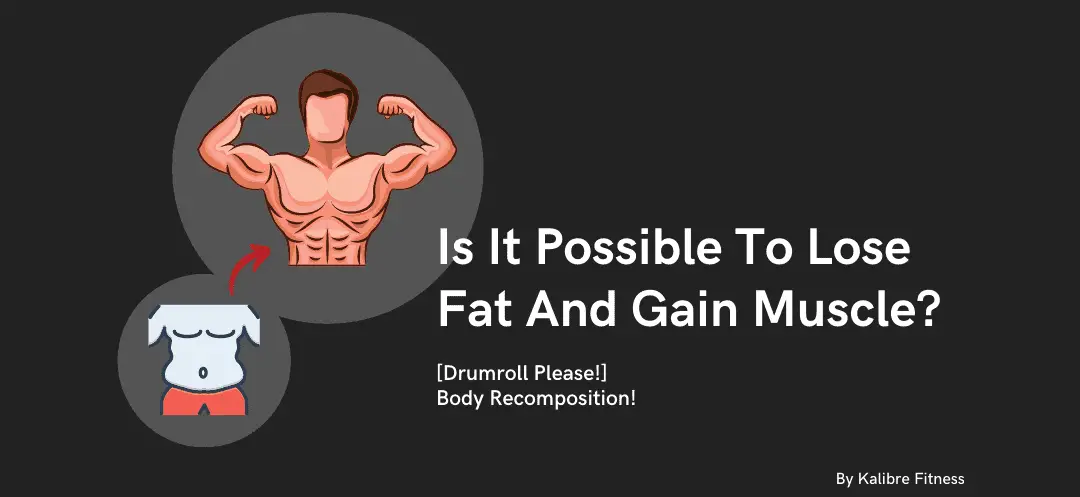Do you long for an athletic-looking physique? You know, the kind of physique you see on the front cover of fitness magazines? If you do, then you have come to the right place! Today, I will provide an in-depth answer to the common dilemma- how to lose fat and gain muscle at the same time.
Like many people, I have worked on achieving a conditioned physique for many years (12 to be exact!). I know the struggles and headaches you go through! This is why I now want to share what I have learnt.
In this post, I will introduce the concept of body recomposition, how recomposition works, and how you can apply 5 principles in your own quest to burn fat and build muscle.
Sound good?
Let’s go!
- An Introduction To Body Recomposition
- How Energy Is Obtained From Food
- 3 Ways The Body Utilises Energy
- How The Body Loses Fat and Gains Muscle
- Fat Loss And Muscle Gain Are Two Opposing Goals
- Body Recomposition (The Best Of Both Worlds)
- Candidates For Recomposition
- The Body Recomposition Programme
- 1. Fat Loss Or Muscle Gain? Choose A Priority!
- 2. Create A Resistance Training Programme To Build Muscle.
- 3. Determine Your Target Daily Calorie Intake
- 4. Optimise Your Diet Around Your Target Calories
- 5. Include Light Cardio (For Fat Loss Only)
- Calorie Cycling- Combining It All together
- Measuring Body Recomposition Results
- Conclusion
An Introduction To Body Recomposition
“Body Recomposition” (changing the body’s fat and muscle ratio) is a practice which has gained a lot of momentum over the years.
Body recomposition is simply an approach to exercise and dieting which aims to decrease fat mass and increase muscle mass.(1)
When applied correctly, it will give you that dream physique, the kind of physique you see on fitness magazine covers.
As Jeff Nippard (from the featured video) suggests, recomposition not only works, but it is a realistic goal for the MAJORITY of people.
Now, Jeff is a professional natural bodybuilder with a degree in Biochemistry. He applies science to his bodybuilding, and he knows his stuff!
What Is Body Composition?
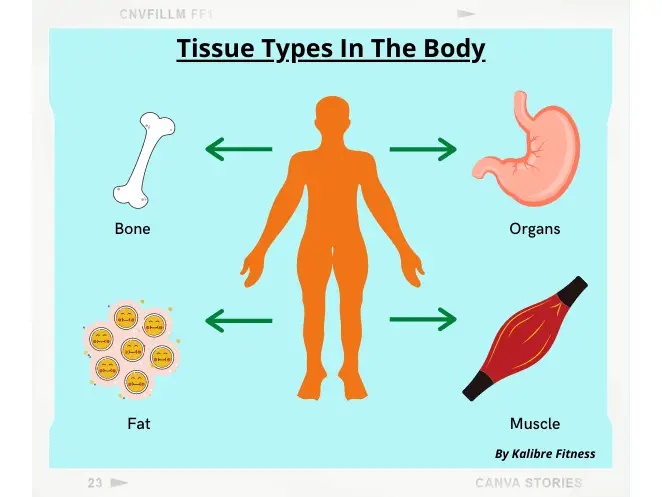
First, let’s understand what the word “body recomposition” even means.
Do you know what the human body is made up of?
It’s a little more complex than just “bones and flesh”.
Many different tissue types come together to form the body. These tissues include bone, organs, fat, muscle, tendons, and more. And they are present in different quantities.
Body composition describes the ratio of these tissues in the body. Generally speaking, it remains unchanged throughout life (How often do we remove an organ from our body right?!)
However, fat and muscle composition CAN and DOES change.
What Is Body RE-composition?
In the sport and nutritional science world, body recomposition (or “recomping”) refers to a diet and exercise approach which aims to change the fat and muscle ratio in the body.
The goal of recomping is to lose fat and gain muscle. This results in the lean physique many of us long for.
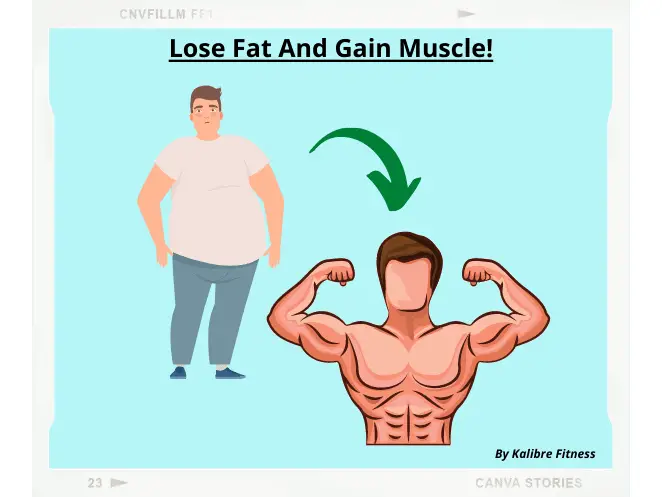
Body recomposition sounds good, right?
But how exactly do we recomp? What exercises and diet changes need to be implemented?
First, we need to start with the basics……
Disclaimer: This is a DEFINITIVE GUIDE, and I will be explaining everything. This includes the science behind fat loss and muscle gain. In my opinion, understanding the way something works will allow you to apply the principles behind the method.
If you would like to, you can skip to “The Body Recomposition Programme”, where I begin explaining how to apply the principles we will explain next..
How Energy Is Obtained From Food
Understanding how to lose fat and gain muscle requires a fundamental understanding of how the body digests food for energy, and how it utilises and stores the energy.
Have you wondered how the body processes foods into energy?
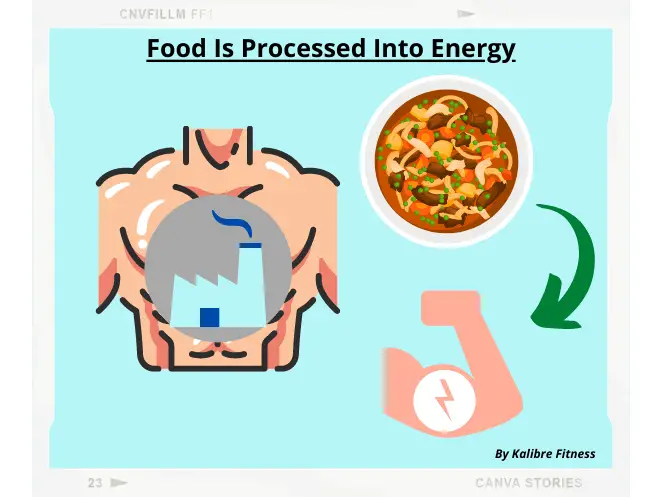
Think of your body as a biological factory. It takes in raw materials, processes these materials into functional products, and uses these products to sustain itself.
In this analogy, the raw materials are the foods you consume, and the functional product is energy (aka calories).
In other words, the body consumes food to produce energy to power itself.
Just like how a real factory prefers to use certain raw materials when it can, the body prefers to use carbohydrates/fats/proteins (in that order) where possible.(2)
Carbohydrates, Fats, and Proteins Provide Energy
How do these 3 nutrients provide energy for the body?
Carbohydrates, fats, and proteins are all large molecules. And they are unsuitable for energy use in their unprocessed forms.
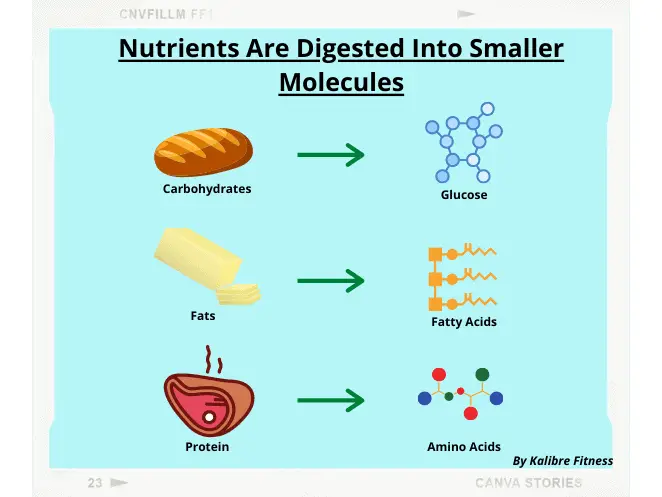
Much like a factory needs to process its raw materials for use, the body needs to digest the nutrients to utilise them for energy:
- Carbohydrates– digested into glucose (used for energy).(3)
- Fats– digested into fatty acids (used for energy).(4)
- Protein– digested into amino acids (converted into glucose and fatty acids).(5)
Thus, digestion converts nutrients into usable forms for energy.
Summary:
- The body processes 3 nutrients (carbohydrates, fats, and proteins) into smaller digested products (glucose, fatty acids, and amino acids).
- The body uses the 3 digested products (glucose, fatty acids, and amino acids) for energy.
- Analogy- a factory processes raw materials (nutrients) into refined materials (digested products) for use (energy).
3 Ways The Body Utilises Energy
At this stage, the body has energy readily available.
So what happens to the energy obtained from digesting carbohydrates, fats, and protein?
Much like how a factory can distribute its products across various channels (for example, using its product directly or selling surplus products), the body can also distribute energy in different ways:
- Fuel daily activities.
- Build muscle.
- Store as fat.

1) Energy To Fuel Daily Activities
The basic physiological processes that keep you alive require energy.
These processes include movement, tissue repair, blood circulation, breathing, thinking, temperature control etc. And they all consume energy throughout the day. This energy is our basal metabolic rate (BMR).
Your daily lifestyle and activities also require energy. These activities include going to work, exercising, housework, childrearing, and any other physical activity.
When you combine the energy expenditure from physical activities with the BMR, you get your total daily energy expenditure (TDDE).
Thus, much like how a factory can sell its own products to sustain its operations, the energy obtained from food digestion can sustain your TDDE.
You can find out your TDDE with this free online TDEE Calculator. Simply plug in your details!
2) Energy To Build Muscle
Muscle tissue is extremely energy demanding.
It is metabolically active tissue, meaning it requires energy to sustain itself (even at rest). Muscle requires energy because the daily contractions cause microscopic damage to the muscle fibres. These are called “micro-tears”, and repairing microtears requires energy.
If you are resistance training to build muscle, then the muscles consume EVEN MORE energy as they adapt to the training by growing larger (muscular hypertrophy).
Therefore the body needs to use energy to build and maintain muscle tissue on a daily basis.
Much like how factory machines will go into disrepair without energy, muscle tissue will also waste away without energy. This is called catabolism.
3) Energy Stored As Fat
When you consume more calories than your TDEE, there is an energy surplus. This is called a caloric surplus.
What happens to the extra energy? Does it vanish into thin air?
Of course, it doesn’t!
If the body consumes more energy than it requires, the surplus is stored in reserves.
Fatty acids come together to form triglycerides which are stored in fatty tissue, whilst glucose molecules come together to form glycogen which is stored in muscle. Glucose can also be converted into triglycerides if muscular glycogen stores are full.
What are the functional differences between triglycerides and glycogen?
Triglycerides store energy for long-term use. They provide a source of energy during emergencies (like when food runs out).
Glycogen stores energy for short-term use. It allows the muscle to quickly access energy for rapid explosive movements (like lifting weights or running away from a sabre tooth tiger!).
Why are there two types of energy stores?
Both types of energy storage differ in the amount of energy they hold, and how rapidly accessible the energy is.
Triglycerides can store more energy than glycogen. However, the energy in glycogen is more rapidly available.
Therefore, like a factory can have short-term hold and long-term storage, the body holds energy in different places depending on when it expects to use it.
The human body is a marvellously complex feat of biological engineering!
Summary:
- 3 ways the body distributes energy from digested food:
- 1) Fuel daily activities.
- 2) Build muscle.
- 3) Store as fat.
- Analogy- a factory can also distribute its own products in multiple ways. 1) sell the product to maintain factory operations (fuel daily activities), 2) use the product to build more products (build muscle), 3) store the away for future use (store as fat).
How The Body Loses Fat and Gains Muscle
In the previous section, I explained how the body uses energy to fuel daily activities, and why some of the energy is stored as fat.
Now I will explain how the body loses fat and builds muscle.
Mechanism For Fat Loss
Fat loss refers to the process where the body burns its own body fat for energy.
But how does the body decide WHEN to burn fat?
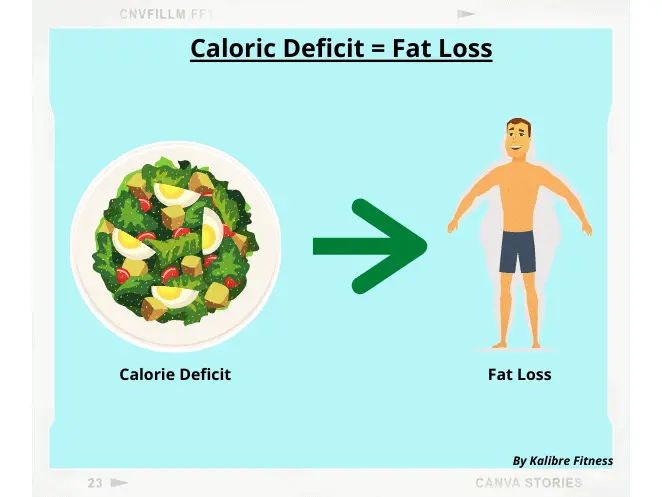
Fat loss requires you to be in a caloric deficit. This means the daily calories consumed is less than the TDEE. When you are in a caloric deficit, your body will find ways to obtain energy from other places.
Ideal energy sources are fatty acids from fat tissue and glycogen and amino acids in the muscle!
Thus, your body will burn fat and muscle to fulfil its energy demands during a caloric deficit. This makes a caloric deficit essential for fat loss.
To learn how to put yourself in a caloric deficit, check out my Guide To Create A Calorie Deficit Guide.
Obviously, you would only like to burn fat and not muscle. And there is a way you can trick your body into retaining muscle mass whilst burning fat (we will explain this later!)
Mechanism For Muscle Gain
Muscle gain refers to the process where the body converts nutrients into the muscle.
How is this done?
Muscle tissue is basically a large mass of muscle fibre. And muscle fibre is composed of protein. To build muscle, your body takes the protein from your diet and uses energy to convert the protein into muscle fibres.
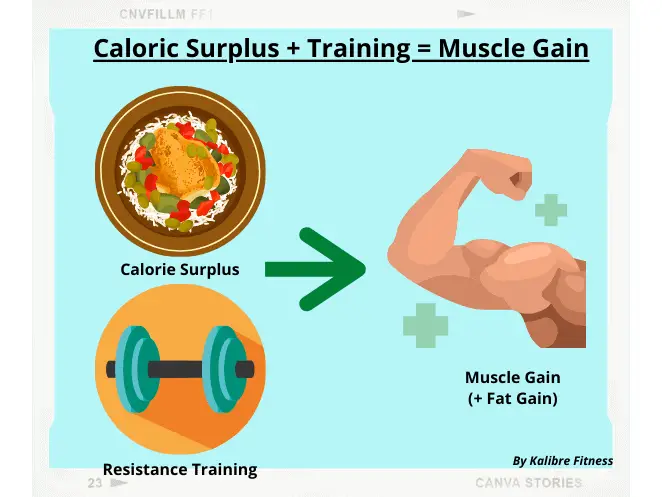
Therefore muscle gain requires a caloric surplus. This means the daily calories consumed are more than the TDEE. When you are in a caloric surplus, your body will distribute the energy to build muscle AND store fat.
So how does the body decide how much muscle to build and how much fat to store?
The body is actually very smart about how it distributes the surplus energy.
From a survival standpoint, it doesn’t make sense for it to waste valuable energy to unnecessarily build and maintain large amounts of muscle. Remember, muscle is also metabolically active tissue and is generally energy-demanding.
Instead, muscle is built as much as it is required.
If there is a high demand for muscle growth, the body will build more muscle. If there is a low demand for muscle growth, the body will store energy as fat.
Resistance training is the most effective way to place increasing demands on your muscle and thereby stimulate muscle growth. Without training, surplus calories will simply be directed to your fat stores.
Summary:
- Fat loss is achieved by going into a caloric deficit. This causes the body to burn muscle and fat for energy.
- Muscle gain is achieved by going into a caloric surplus. This causes the body to direct the extra energy into both muscle gain AND fat gain.
- From a survival standpoint, the body prefers to store fat than to build muscle.
- Resistance training will stimulate muscle gain OVER fat gain.
Fat Loss And Muscle Gain Are Two Opposing Goals

In the previous section, I explained how fat is lost and how muscle is built.
Fat loss requires a caloric deficit, whilst building muscle requires a caloric surplus combined with resistance training.
So how can you lose fat AND build muscle simultaneously?
Surely it’s not physically possible to be in both a caloric deficit AND surplus simultaneously. They are completely opposing terms, right?
You have read this far. You understand the science behind fat loss and muscle gain. That’s a great achievement in itself.
Now things will become interesting.
Let’s explain how you can burn fat AND build muscle, at the SAME TIME!
Body Recomposition (The Best Of Both Worlds)

On paper, yes, burning fat and building muscle are theoretically opposing mechanisms. One encourages a caloric deficit, whilst the other encourages a caloric surplus.
But in reality, the body is a marvellously complex and adaptable system.
By taking a smart approach to dieting and exercise, you can direct the body to lose fat whilst building muscle.
This is body recomposition.
Candidates For Recomposition
Body recomposition is an industry-vouched approach to building a lean and muscular physique.
As Jeff Nippard (from the featured video) explains, body recomposition not only works but it can also be achieved by the general population.
These people will gain the most benefits from recomposition:
1) Beginners and novices
2) Advanced weight lifters who have a below-average commitment to their training.
3) Physically deconditioned lifters
4) Overweight or obese people.
Beginner/Novice Lifters
These are people who have been weight training for 0 to 6 months. Their muscles are still “naive” and highly responsive to growth when stimulated by resistance training. Resistance training will also prime their body for fat loss. These people will gain the biggest benefits from recomposition.
Intermediate/Advanced Lifters
These are people who have been training for 6 months to 2+ years. If they haven’t given their maximum effort to training during this period, their muscles will also be responsive to further growth.
Deconditioned Lifters
These are people who have previously been in peak strength and condition but regressed due to injury or other commitments. Their muscles will have the unique benefit of muscle memory.
Muscle memory refers to the ability of muscle tissue to rapidly recruit the metabolic machinery (cell components responsible for energy processing) and neural innervation developed with past training. This allows the muscle to quickly regain strength and size.
Overweight and Obese People
These people are also highly responsive to recomposition. Due to their excess fat reserves, these individuals are able to be in a caloric deficit and utilise energy from their fat mass to build muscle.
Do you belong to any of these 4 categories?
If you do keep on reading to find out how to recomp!
Note for advanced lifters: your muscles may be desensitised and less responsive to further growth. Recomposition is still possible in these individuals, but the effects may be less pronounced. It may be a better idea to go on a cut instead!
Summary:
- Recomposition is achievable by most people!
- Truly advanced lifters may want to go on a cut instead of recomposition.
The Body Recomposition Programme

I will now explain the methods to achieve recomposition. You’ve taken the time to learn the science behind fat loss and muscle gain. Now you can apply the principles!
At its core, body recomposition requires consistent resistance training combined with a caloric deficit diet.
I emphasise the word “consistent”.
As with most fitness goals, body recomposition is not something which will happen overnight.
Depending on your current body composition and abilities, it can take months to over a year of dedicated work. It will require sticking to a high-protein diet combined with relatively intense resistance training at least 3 times a week.
Do you think you have what it takes?
If so, then keep on reading to learn how to achieve recomposition!
1. Fat Loss Or Muscle Gain? Choose A Priority!
Your first task is to prioritise a goal.
Do you want to focus on fat loss or muscle gain?
Although recomposition will provide overall benefits to fat loss and muscle gain, focusing your programme on one goal will give you greater returns.
How do you know if you should focus on losing fat or gaining muscle?
First, you need to determine whether you are classified as lean or not-so-lean.

Jeff recommends lean individuals focus on building muscle, and not-so-lean individuals focus on fat loss.
For those who choose to focus on building muscle, a 5-25% caloric surplus (relative to TDEE) is ok. If you are naturally very lean or genetically gifted to build muscle, you can afford to go closer to 25%.
For those who focus on losing fat, a 10-20% calorie deficit (relative to TDEE) should be maintained.
For example: If I am a lean male (~12% body fat) with a TDEE of 2500 calories, I would consume ~2750 calories each day (a 10% surplus of 2500 calories). This would put me in a 250-calorie surplus.
This makes sense since leaner individuals (who have very little body fat) can afford to be in a slight caloric surplus to build muscle quicker.
In contrast, not-so-lean individuals do not want to gain even more body fat by going into a caloric surplus. Instead, they should go on a caloric deficit and rely on their current body fat to fuel muscle growth.
Check out this body fat comparison chart by Train Beyond The Box to determine if you are classified as lean or not-so-lean!
Summary:
- Prioritise a goal- fat loss or muscle gain?
- Determine if you are lean or not-so-lean by establishing your body fat % (use the chart from Train Beyond The Box).
- Lean individuals should focus on building muscle by going on a mild caloric surplus.
- Not-so-lean individuals should focus on losing fat by going on a mild caloric deficit.
2. Create A Resistance Training Programme To Build Muscle.
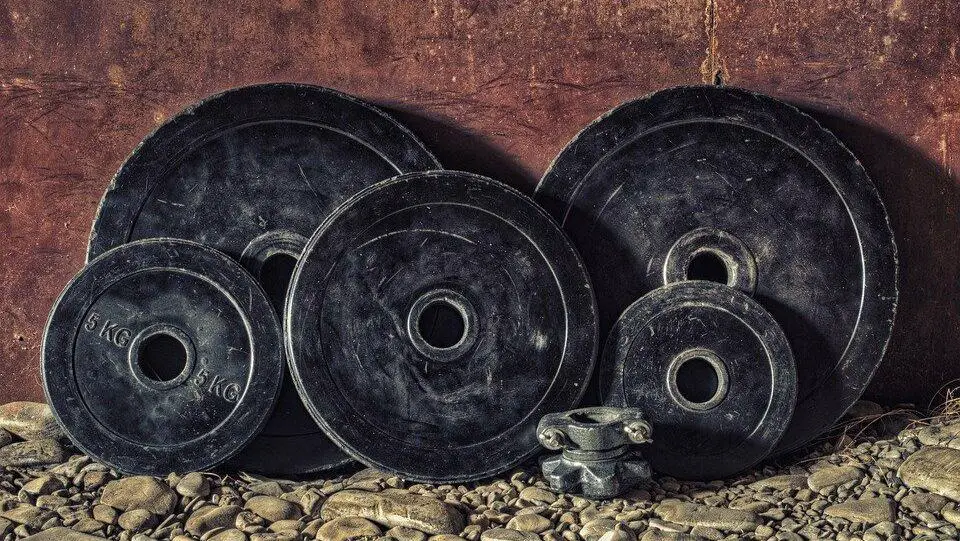
Without resistance training, the body will not build significant muscle mass. Therefore, resistance training is absolutely critical to driving recomposition.
Lifting weights is a popular (and arguably the most effective) form of resistance training.
But some people prefer using resistance bands, bodyweight exercises, or kettlebells. These can be good ways for beginners to build up to weight lifting.
Training Frequency And Intensity
All muscle groups should be worked throughout the week, at least twice a week.
Regardless of the exercise, training should be relatively intense. This means it should push your body enough to stimulate muscle growth. An intense workout will increase your resting heart rate by 70-80% and this should be enough for you to get a sweat on.
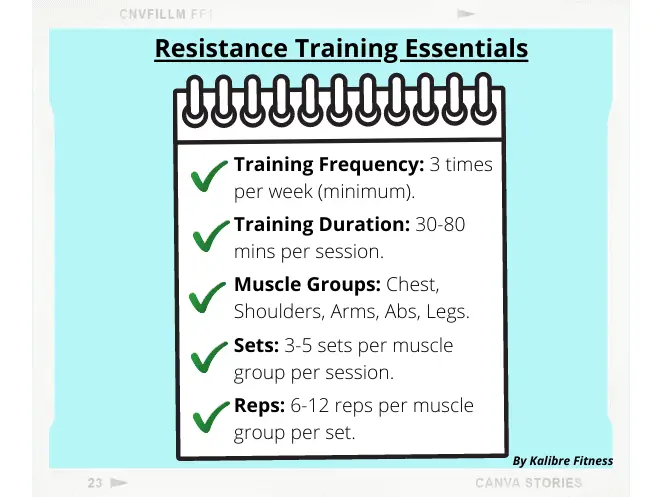
Resistance training needs to be performed at least 3 times per week, each session lasting at least 30 minutes.
The best exercises are big compound exercises. These exercises will most effectively stimulate muscle growth and fat loss.
Each exercise needs to be performed with weight loads that allow for 3-5 sets of 6-12 reps. If you aren’t struggling in the last set, then you need to increase the weight load!.
Finally, you should progressively increase the training intensity every week or so.
This is called progressive overload. And overloading your muscles it will force them to keep growing.
This is a very brief introduction to resistance training for recomposition. Check out our simple barbell workout plan for an example training program and an in-depth explanation of these training principles.
Summary:
- Resistance training is ESSENTIAL for muscle growth.
- Training should be intense and performed at least 3 times a week.
- All muscle groups should be worked throughout the week.
- Checkout my workout for fat loss and muscle gain guide for in-depth training tips.
3. Determine Your Target Daily Calorie Intake
Resistance training needs to be combined with a diet plan to achieve the best results.
Jeff Nippard compares training and diet to the engine and fuel in a car.
Both are important in their own ways to achieve results. Resistance training is the main driver of recomposition. But without good quality fuel (nutrition), the benefits of training will be limited.
Therefore the next step is to determine your target daily calorie intake. In other words, how many calories you should consume every day?
How do you establish your target daily calorie intake?
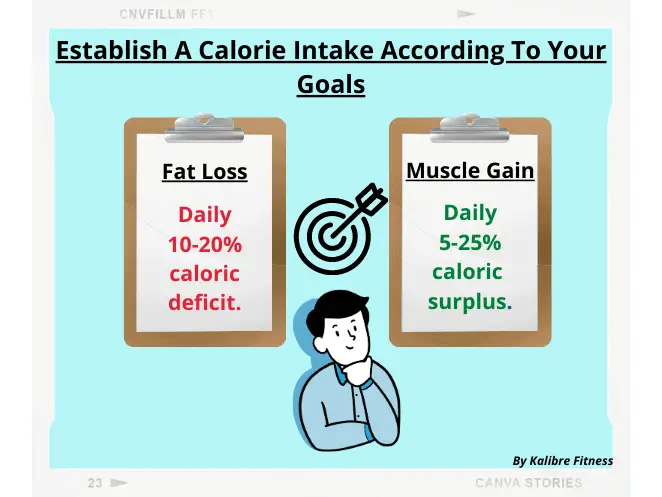
As explained by Jeff, your daily calorie intake will depend on whether your priority goal is to lose fat or gain muscle (as discussed above).
If your primary goal is to lose fat, you will need to maintain a mild caloric deficit of 10-20% below TDEE (equates to ~300 calorie deficit).
If your primary goal is to gain muscle, you will need to maintain a slight caloric surplus of ~15% above TDEE (again equates to roughly a 300-calorie surplus).
Online TDEE calculators make it easy to determine your TDEE. Simply plug in your details!
For example: If my TDEE is 2500 calories, a mild calorie deficit would be ~2150 calories. In other words, I would aim to consume 2150 calories every day. In contrast, a mild calorie surplus would be ~2875 calories.
If you would like to learn how to calorie count to hit your daily target calories, check out my How To Create A Calorie Deficit Guide.
Summary:
- Establish a daily target calorie intake according to your goals.
- If your primary goal is to lose fat, choose a mild caloric deficit that is 10-20% below TDEE.
- If your primary goal is to gain muscle, choose a mild caloric surplus that is 15% above TDEE.
- Calculate your TDEE with online TDEE calculators.
4. Optimise Your Diet Around Your Target Calories
After you have established your target daily calories, you need to build a nutrition plan (diet) around those calories.
Remember when I explained how a caloric deficit will result in fat AND muscle being burnt?
Obviously, we don’t want the body to burn muscle. So there’s a trick you can utilise to prevent this from happening!
Protein
Consuming high amounts of protein is essential to build and maintain muscle during body recomposition, especially in a caloric deficit. If your daily protein intake is insufficient, you will find your muscle will not grow. Even worse, muscle mass could even decrease (if you are in a severe caloric deficit).
Therefore eating high amounts of protein is essential for muscle growth during recomposition.
How much protein should you consume?
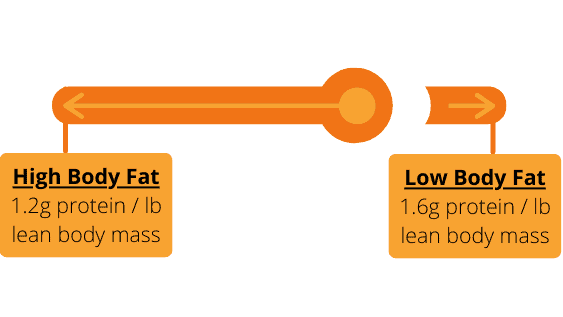
Jeff Nippard proposes a “sliding model for protein intake“. If you are on the leaner side, aim for 1.6g of protein per pound of body weight. If you are on the not-so-lean side, aim for 1.2g of protein per pound of body weight.
For example, I am a semi-lean 155 pounds male, so I would aim to consume 215 grams of protein every day.
Protein as a nutrient also has a high thermic effect. This means a lot of energy is required to simply digest to make it suitable for the body. This means a high protein diet will also facilitate weight loss whilst helping to build muscle.
Fats
Contrary to popular belief, dietary fats aren’t all bad for you. In fact, healthy fats (found in foods like nuts, oily fish, and vegetable oils) are essential for body recomposition, and health in general.
How much fat should you be consuming?
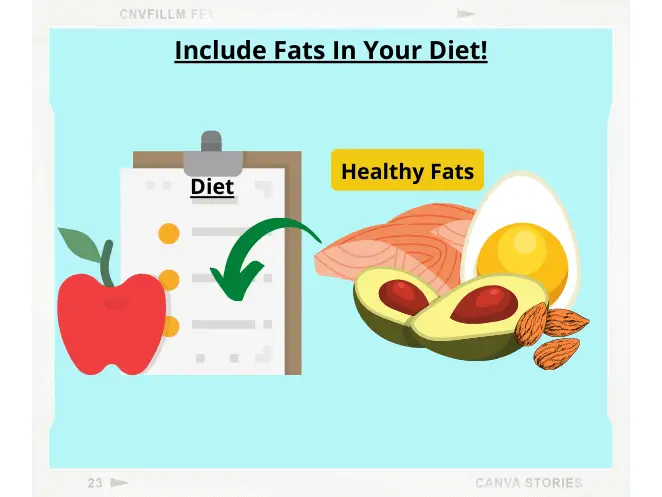
Jeff recommends consuming around 20% of your daily calories from fats.
Fats are important because they will provide the energy to fuel your workouts (along with carbs). They also have important roles in vitamin/mineral absorption and hormone production.
An example of a hormone important for recomposition is Testosterone. It is associated with muscle development and fat loss. And testosterone production requires cholesterol (a type of fat).
So don’t eliminate fats from your diet!
Carbohydrates
The rest of your caloric intake should be filled in with complex carbohydrates and fibre.
Carbohydrates are digested into glucose, which is vital to fuel your muscles during a workout. The harder you work on a muscle, the more it will grow.
Therefore it is critical to provide your body with energy to 1) push your muscles during a workout, and 2) fuel the growth and repair process after a workout.
For the greatest recomposition results, you should time your daily carbohydrate consumption.
What does this mean?
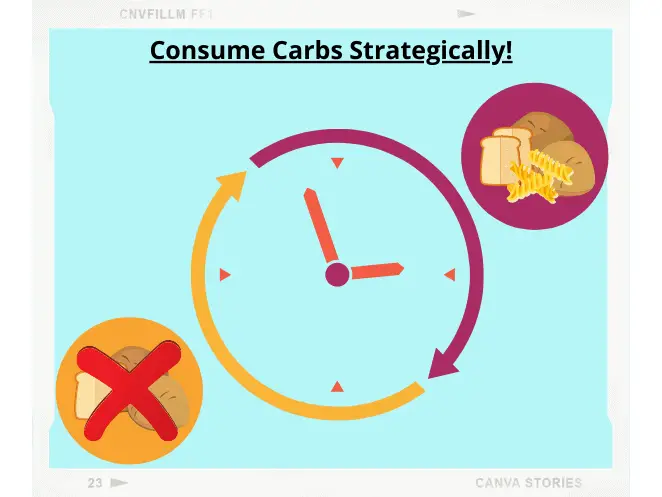
Basically, carbs should be consumed strategically throughout the day.
In other words, aim to consume complex carbohydrates (such as whole grains and potatoes) before and immediately after a workout, or during the day. This will allow your body time to burn them off and use the energy to build muscle.
If you consume lots of carbs at night, you risk the energy being stored as fat. So this should be limited where possible.
I will be releasing a post on dieting for recomposition soon, so stay tuned!
Summary:
- Build your diet around your target daily calorie intake.
- A high protein intake will allow your body to build and maintain muscle (even during a caloric deficit!).
- Fats and carbs are essential to fuel your workouts.
5. Include Light Cardio (For Fat Loss Only)
A resistance training programme combined with a diet plan will be sufficient for recomposition.
However, some of you may be super eager to burn off extra fat!
If you are one of these people, cardio can be incorporated into your training programme to facilitate fat loss. Although cardio can help supercharge fat loss, but it is not essential. Rather, you should prioritise your time on committing to resistance training and maintaining your diet instead.
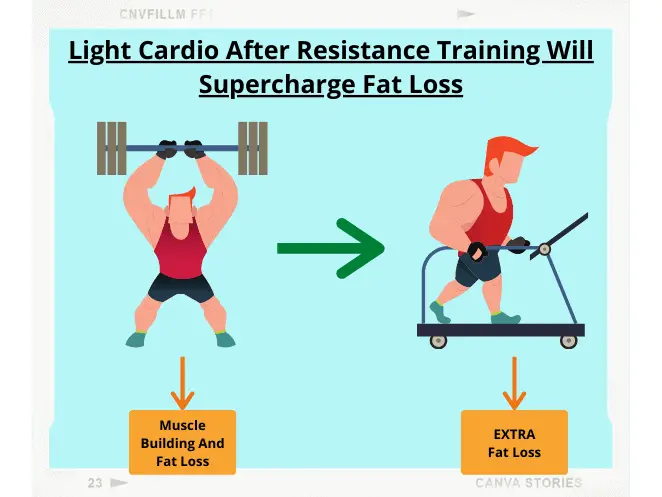
When I am trying to burn extra fat during a cut, I like to do a 20-minute brisk incline walk immediately after my resistance workout. This is a prime window for direct fat-burning because blood glucose and muscular glycogen stores are low.
If you do decide to include cardio, do it at a light intensity and immediately after a resistance workout. By keeping cardio light, you reduce the risk of tipping yourself into a major caloric deficit (and start burning into muscle!).
You don’t want your resistance training to be done in vain!
Summary:
- Cardio will facilitate fat loss, but it is not essential in recomposition.
- If you decide to include cardio, keep it light and at a short duration to limit the risk of burning into muscle.
Calorie Cycling- Combining It All together
Calorie cycling is the finishing touch you can make to your recomposition programme. It involves tailoring your daily calorie intake according to our training and resting days.
It works like this:
On training days, consume either your maintenance calories (your TDEE) or a mild caloric surplus.
If your primary goal is to lose fat, then consume maintenance calories. If your primary goal is to build muscle, then consume surplus calories. These calories will fuel your workout and provide energy for muscle growth.
On rest days, consume either a mild caloric deficit or your maintenance calories. If your primary goal is to lose fat, then consume a caloric deficit. If your goal is to gain muscle, then consume your maintenance calories
Regardless of your goal, ensure you consume high protein every day.
A combined training programme and calorie cycling diet plan would look something like this:
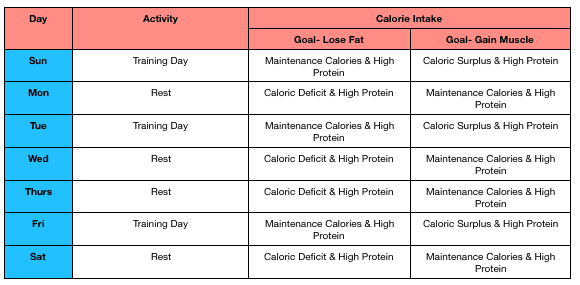
Diet cycling is a popular method used by many personal trainers for their clients because it is highly effective at torching calories whilst maintaining muscle.
Although it is technically more advanced, it will produce quick recomposition results.
I advise beginners first to master sticking consistently to a training programme and diet before moving to calorie cycling.
Remember, if you are a beginner, your body will quickly lose fat and naturally start building muscle in response to resistance training anyway (just make sure you consume enough protein!).
Summary:
- Calorie cycling supplies your body with energy to build muscle on training days and limits energy to burn fat on rest days.
- If your goal is to lose fat, consume maintenance calories on training days, and deficit calories on rest days.
- If your goal is to gain muscle, consume surplus calories on training days, and maintenance calories on rest days.
- Remember, high protein every day! (I think you understand the importance of protein by now).
Measuring Body Recomposition Results

Throughout your recomposition journey, it is important to understand how to track your results. This is because body recomposition is different to an ordinary weight loss plan.
Since you are building muscle and losing fat simultaneously, body weight may not change significantly. In fact, weight may actually increase, since muscle is denser than fat.
Whether your weight increases, decreases or remains the same, will depend on your body composition before you started.
A more reliable way to track results is to weigh yourself and take photographs every week. Pictures should be taken at identical locations and angles, with the same lighting.
This way, you can see your body change positively throughout your journey!
Other ways you can track your results are by taking body measurements (like bicep diameter) and tracking training weight load. If you are recomping successfully, your muscles will be getting both bigger and stronger!
Summary:
- Do not judge recomposition results by body scales.
- Track progress with photos, body measurements, and training records.
Conclusion
There we have it!
Today, I have answered a common dilemma facing many people- how to lose fat and gain muscle at the same time.
I have introduced the concept of energy utilisation in fat loss and muscle gain, body recomposition, why recomposition works, and how to apply a 5 step plan to your training and nutrition plan.
As I have explained in this post, burning fat and building fat is not only possible, but it’s realistic for most people!
All you require is a bit of knowledge and dedication.
I have provided you with the knowledge. And I hope you can provide yourself with the dedication!
Have you got any additional tips for recomposition that I have not covered today?
Feel free to send me a message if you have any questions! You can find my details on the “contact us” page.
You may also be interested in the downloadable Kalibre Blueprint PDF which details exactly how I gained 40lbs of lean muscle (it’s 100% free!). It details the exact exercises and nutrition (with printable worksheets) I used to go from skinny to ripped!
Thanks for reading guys!
Peace Out,
Kal
(Biochemistry BSc, Biomedical Sciences MSc, Ex-Skinny Guy)

